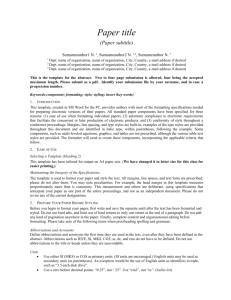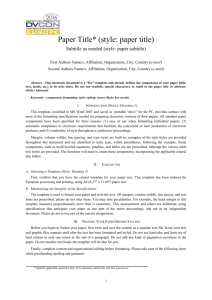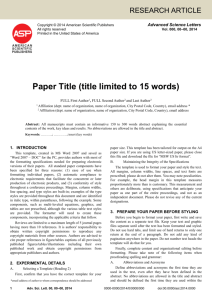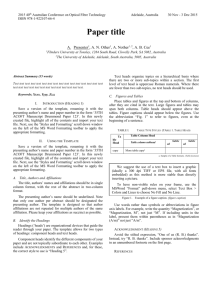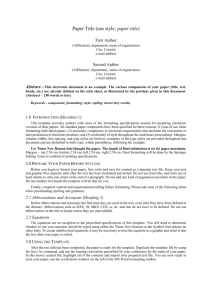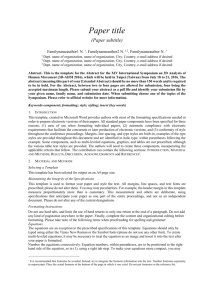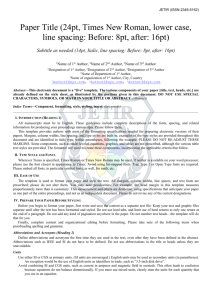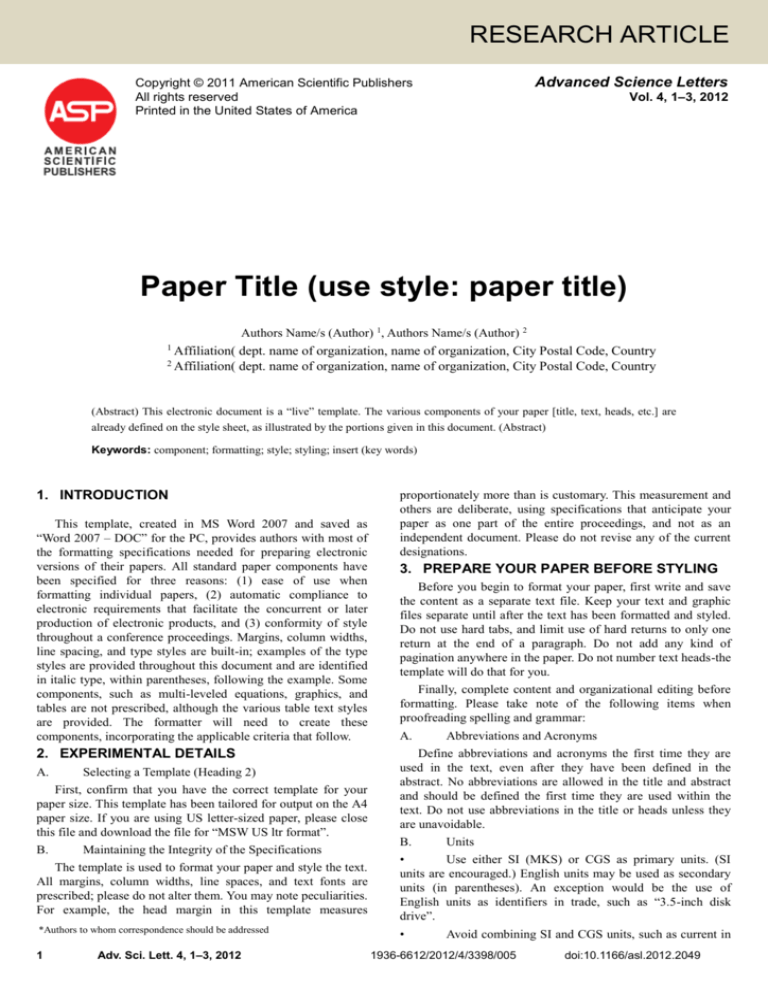
RESEARCH ARTICLE
Advanced Science Letters
Copyright © 2011 American Scientific Publishers
All rights reserved
Printed in the United States of America
Vol. 4, 1–3, 2012
Paper Title (use style: paper title)
Authors Name/s (Author) 1, Authors Name/s (Author) 2
1 Affiliation(
2 Affiliation(
dept. name of organization, name of organization, City Postal Code, Country
dept. name of organization, name of organization, City Postal Code, Country
(Abstract) This electronic document is a “live” template. The various components of your paper [title, text, heads, etc.] are
already defined on the style sheet, as illustrated by the portions given in this document. (Abstract)
Keywords: component; formatting; style; styling; insert (key words)
1. INTRODUCTION
This template, created in MS Word 2007 and saved as
“Word 2007 – DOC” for the PC, provides authors with most of
the formatting specifications needed for preparing electronic
versions of their papers. All standard paper components have
been specified for three reasons: (1) ease of use when
formatting individual papers, (2) automatic compliance to
electronic requirements that facilitate the concurrent or later
production of electronic products, and (3) conformity of style
throughout a conference proceedings. Margins, column widths,
line spacing, and type styles are built-in; examples of the type
styles are provided throughout this document and are identified
in italic type, within parentheses, following the example. Some
components, such as multi-leveled equations, graphics, and
tables are not prescribed, although the various table text styles
are provided. The formatter will need to create these
components, incorporating the applicable criteria that follow.
2. EXPERIMENTAL DETAILS
A.
Selecting a Template (Heading 2)
First, confirm that you have the correct template for your
paper size. This template has been tailored for output on the A4
paper size. If you are using US letter-sized paper, please close
this file and download the file for “MSW US ltr format”.
B.
Maintaining the Integrity of the Specifications
proportionately more than is customary. This measurement and
others are deliberate, using specifications that anticipate your
paper as one part of the entire proceedings, and not as an
independent document. Please do not revise any of the current
designations.
3. PREPARE YOUR PAPER BEFORE STYLING
Before you begin to format your paper, first write and save
the content as a separate text file. Keep your text and graphic
files separate until after the text has been formatted and styled.
Do not use hard tabs, and limit use of hard returns to only one
return at the end of a paragraph. Do not add any kind of
pagination anywhere in the paper. Do not number text heads-the
template will do that for you.
Finally, complete content and organizational editing before
formatting. Please take note of the following items when
proofreading spelling and grammar:
A.
Abbreviations and Acronyms
Define abbreviations and acronyms the first time they are
used in the text, even after they have been defined in the
abstract. No abbreviations are allowed in the title and abstract
and should be defined the first time they are used within the
text. Do not use abbreviations in the title or heads unless they
are unavoidable.
B.
Units
The template is used to format your paper and style the text.
All margins, column widths, line spaces, and text fonts are
prescribed; please do not alter them. You may note peculiarities.
For example, the head margin in this template measures
•
Use either SI (MKS) or CGS as primary units. (SI
units are encouraged.) English units may be used as secondary
units (in parentheses). An exception would be the use of
English units as identifiers in trade, such as “3.5-inch disk
drive”.
*Authors to whom correspondence should be addressed
•
1
Adv. Sci. Lett. 4, 1–3, 2012
Avoid combining SI and CGS units, such as current in
1936-6612/2012/4/3398/005
doi:10.1166/asl.2012.2049
RESEARCH ARTICLE
Adv. Sci. Lett. 4, 1–3, 2012
amperes and magnetic field in oersteds. This often leads to
confusion because equations do not balance dimensionally. If
you must use mixed units, clearly state the units for each
quantity that you use in an equation.
•
Do not mix complete spellings and abbreviations of
units: “Wb/m2” or “webers per square meter”, not “webers/m2”.
Spell out units when they appear in text: “. . . a few henries”,
not “. . . a few H”.
•
Use a zero before decimal points: “0.25”, not “.25”.
Use “cm3”, not “cc”. (bullet list)
C.
Equations
The equations are an exception to the prescribed
specifications of this template. You will need to determine
whether or not your equation should be typed using either the
Times New Roman or the Symbol font (please no other font).
To create multileveled equations, it may be necessary to treat
the equation as a graphic and insert it into the text after your
paper is styled.
Number equations consecutively. Equation numbers, within
parentheses, are to position flush right, as in (1), using a right
tab stop. To make your equations more compact, you may use
the solidus ( / ), the exp function, or appropriate exponents.
Italicize Roman symbols for quantities and variables, but not
Greek symbols. Use a long dash rather than a hyphen for a
minus sign. Punctuate equations with commas or periods when
they are part of a sentence, as in
⑴
Note that the equation is centered using a center tab stop. Be
sure that the symbols in your equation have been defined before
or immediately following the equation. Use “(1)”, not “Eq. (1)”
or “equation (1)”, except at the beginning of a sentence:
“Equation (1) is . . .”
D.
Some Common Mistakes
•
The word “data” is plural, not singular.
•
other common scientific constants, is zero with subscript
formatting, not a lowercase letter “o”.
•
In American English, commas, semi-/colons, periods,
question and exclamation marks are located within quotation
marks only when a complete thought or name is cited, such as a
title or full quotation. When quotation marks are used, instead
of a bold or italic typeface, to highlight a word or phrase,
punctuation should appear outside of the quotation marks. A
parenthetical phrase or statement at the end of a sentence is
punctuated outside of the closing parenthesis (like this). (A
parenthetical sentence is punctuated within the parentheses.)
•
A graph within a graph is an “inset”, not an “insert”.
The word alternatively is preferred to the word “alternately”
(unless you really mean something that alternates).
•
Do not use the word “essentially”
“approximately” or “effectively”.
to
mean
•
In your paper title, if the words “that uses” can
accurately replace the word “using”, capitalize the “u”; if not,
keep using lower-cased.
•
Be aware of the different meanings of the homophones
“affect” and “effect”, “complement” and “compliment”,
“discreet” and “discrete”, “principal” and “principle”.
•
Do not confuse “imply” and “infer”.
•
The prefix “non” is not a word; it should be joined to
the word it modifies, usually without a hyphen.
•
There is no period after the “et” in the Latin
abbreviation “et al.”.
•
The abbreviation “i.e.” means “that is”, and the
abbreviation “e.g.” means “for example”.
4. USING THE TEMPLATE
After the text edit has been completed, the paper is ready for
the template. Duplicate the template file by using the Save As
command, and use the naming convention prescribed by your
conference for the name of your paper. In this newly created
file, highlight all of the contents and import your prepared text
file. You are now ready to style your paper; use the scroll down
window on the left of the MS Word Formatting toolbar.
A.
Authors and Affiliations
The template is designed so that author affiliations are not
repeated each time for multiple authors of the same affiliation.
Please keep your affiliations as succinct as possible (for
example, do not differentiate among departments of the same
organization). This template was designed for two affiliations.
B.
Identify the Headings
Headings, or heads, are organizational devices that guide the
reader through your paper. There are two types: component
heads and text heads.
Component heads identify the different components of your
paper and are not topically subordinate to each other. Examples
include ACKNOWLEDGMENTS and REFERENCES and, for
these, the correct style to use is “Heading 5”. Use “figure
caption” for your Figure captions, and “table head” for your
table title. Run-in heads, such as “Abstract”, will require you to
apply a style (in this case, italic) in addition to the style
provided by the drop down menu to differentiate the head from
the text.
Text heads organize the topics on a relational, hierarchical
basis. For example, the paper title is the primary text head
because all subsequent material relates and elaborates on this
one topic. If there are two or more sub-topics, the next level
head (uppercase Roman numerals) should be used and,
conversely, if there are not at least two sub-topics, then no
subheads should be introduced. Styles named “Heading 1”,
“Heading 2”, “Heading 3”, and “Heading 4” are prescribed.
C.
Figures and Tables
1) Positioning Figures and Tables: Each table must be
referred to in the text. Each table should be typed doublespaced on a separate sheet and identified sequentially by Arabic
numerals corresponding to the order in which they appear in the
text. Each table should have a brief explanatory title, which
should be labeled unambiguously. The position of each table
should be clearly marked in the text.Place figures and tables at
the top and bottom of columns. Avoid placing them in the
middle of columns. Large figures and tables may span across
both columns. Figure captions should be below the figures;
table heads should appear above the tables. Insert figures and
tables after they are cited in the text. Use the abbreviation “Fig.
1”, even at the beginning of a sentence.
2
RESEARCH ARTICLE
TABLE I.
Table
Head
copy
Adv. Sci. Lett. 4, 1–3, 2012
TABLE TYPE STYLES
Table Column Head
Table column subhead
Subhead
More table copya
Subhead
a. Sample of a Table footnote. (Table footnote)
We suggest that you use a text box to insert a graphic (which
is ideally a 300 dpi TIFF or EPS file, with all fonts embedded)
because, in an MSW document, this method is somewhat more
stable than directly inserting a picture.
To have non-visible rules on your frame, use the MSWord
“Format” pull-down menu, select Text Box > Colors and Lines
to choose No Fill and No Line.
Figure 1.
Example of a figure caption. (figure caption)
Figure Labels: Use 8 point Times New Roman for Figure
labels. Use words rather than symbols or abbreviations when
writing Figure axis labels to avoid confusing the reader. As an
example, write the quantity “Magnetization”, or “Magnetization,
M”, not just “M”. If including units in the label, present them
within parentheses. Do not label axes only with units. In the
example, write “Magnetization (A/m)” or “Magnetization
{A[m(1)]}”, not just “A/m”. Do not label axes with a ratio of
quantities and units. For example, write “Temperature (K)”, not
“Temperature/K”.
ACKNOWLEDGMENTS:
The preferred spelling of the word “acknowledgment” in
America is without an “e” after the “g”. Avoid the stilted
expression, “One of us (R. B. G.) thanks . . .” Instead, try “R. B.
G. thanks”. Put sponsor acknowledgments in the unnum-bered
footnote on the first page.
REFERENCES AND NOTES
The template will number citations consecutively within
brackets [1]. The sentence punctuation follows the bracket [2].
Refer simply to the reference number, as in [3]—do not use
“Ref. [3]” or “reference [3]” except at the beginning of a
sentence: “Reference [3] was the first ...”
Number footnotes separately in superscripts. Place the
actual footnote at the bottom of the column in which it was
cited. Do not put footnotes in the reference list. Use letters for
table footnotes.
Unless there are six authors or more give all authors’ names;
do not use “et al.”. Papers that have not been published, even if
they have been submitted for publica-tion, should be cited as
“unpublished”. Papers that have been accepted for publication
should be cited as “in press”. Capitalize only the first word in a
paper title, except for proper nouns and element symbols.
3
For papers published in translation journals, please give the
English citation first, followed by the original foreign-language
citation [4-9].
For example, [1] is for a journal paper, [2] is for a
conference proceedings, [3] is for transactions, [4] is for a book,
[5] is article or chapter in an edited book, [6] is for a thesis, [7]
is for article in proceedings, [8] is for article from internet, [9]
is for a patent.
Please completely normalize your references as the
following format. Please register your email at
http://www.crossref.org/requestaccount/ and retrieve Digital
Object Identifiers (DOIs) for journal articles, books, and
chapters by simply cutting and pasting the reference list at
http://www.crossref.org/SimpleTextQuery/. Preserve hyperlinks
and underlines in DOIs and URLs.
1. Massart Thierry, Meuter Cedric, V B Laurent. On the complexity
of partial order trace model checking, Inform. Process. Lett. 106 (2008)
120-126
2. J. Kimura and H. Shibasaki, Editors. Recent Advances in Clinical
Neurophysiology. Proceedings of the 10th International Congress of
EMG and Clinical Neurophysiology, (1995) October 15-19; Kyoto,
Japan.
3. Ortega, R., Loria, A. and Kelly, R. (1995) A semiglobally stable
output feedback PI2D regulator for robot mani- pulators. IEEE
Transactions on Automatic Control, 40, 1432-1436.
4. H. S. Nalwa, Editor, Magnetic Nanostructures, American Scientific
Publishers, Los Angeles (2003).
5. H. V. Jansen, N. R. Tas and J. W. Berenschot, in Encyclopedia of
Nanoscience and Nanotechnology, Edited H. S. Nalwa, American
Scientific Publishers, Los Angeles (2004), Vol. 5, pp.163-275.
6. Giambastiani, B.M.S. (2007) Evoluzione idrologica ed
idrogeologica della pineta di San Vitale (Ravenna). Ph.D. Thesis,
Bologna University, Bologna.
7. Wu, J.K. (1994) Two problems of computer mechanics program
system. Proceedings of Finite Element Analysis and CAD, Peking
University Press, Beijing, 9-15.
8. Honeycutt, L. (1998) Communication and design course.
9. C. E. Larsen, R. Trip, and C.R. Johnson, Methods for procedures
related to the electrophysiology of the heart. U.S. Patent 5,529,067,
Jun 25 (1995).
Received: 1 April 2012. Accepted: 15 May 2012

